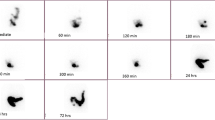Abstract
The pH and transit times of the gut areimportant for the delivery of active drug from severaltablets used in the treatment of Crohn's disease (CD).Many patients with CD undergo an ileocecal resection, which might influence small intestinal pH andtransit time. The effect of ileocecal resection on thesevariables has not previously been studied. IntraluminalpH and transit time were measured in nineileocecal-resected CD patients and 13 healthy volunteers usingpH-sensitive radiocapsules. Small intestinal transittime (SITT) was significantly shorter inileocecal-resected patients (5.2 hr, controls 8.0 hr).The pH levels of the small intestine were identical inpatients and controls, whereas cecal pH was 0.9 pH unitshigher in resected CD patients. The time spent with pHhigher than 5.5, 6.0, 6.5, and 7.0 was significantly shorter in patients than in controls. There wasno correlation between the SITT and the length ofresected ileum or between the SITT and the time elapsedsince the resection. We conclude that ileocecal resection decreases the SITT and the time withpH higher than 5.5-7.0. The study indicates that thisreduction of the SITT is mainly due to the resection ofthe ileocecal valve and is, to a certain extent, independent of the length of resected ileum. Anileocecal resection might therefore affect the deliveryof active drug from tablets with pH-dependentdelivery.
Similar content being viewed by others
REFERENCES
Sasaki Y, Hada R, Nakajima H, Fukuda S, Munakata A: Improve d localizing me thod of radiopill in measurement of entire gastrointestinal pH pro(r) les: Colonic luminal pH in normal subjects and patients with Crohn's disease. Am J Gastroenterol 92:114-118, 1997
Munkholm P, Langholz E, Davidse n M, Binder V: Intestinal cancer risk and mortality in patients with Crohn's disease. Gastroente rology 105:1716-1723, 1993
Colson RH, Watson BW, Fairclough PD, Walker-Smith JA, Cambell CA, Bellamy D, Hinsull SM: An accurate, long-term, pH-sensitive radio pill for ingestion and implantation. Biotelemetry Patient Monit 8:213-227, 1981
Kholoussy AM, Yang Y, Bonacquisti K, Witkowski T, Takenaka K, Masumoto T: The compe tence and bacteriologic e ffect of the telescoped intestinal valve after small bowel re se ction. Am Surg 52:555-559, 1986
Ecker KW, Pistorius G, Harbauer G, Fe ifel G: Die bacte rielle Clearance des te rminalen Ileums in Abhangigkei t von der ileokolischen Konne ktion. Zentralbl Chir 120:336-342, 1995
Fallingborg J, Christensen LA, Ingeman-Nie lsen M, Jacobsen BA, Abildgaard K, Rasmussen HH: pH-profile and regional transit times of the normal gut measure d by a radiotelemetry device. Aliment Pharmacol Ther 3:605-613, 1989
Evans DF, Pye G, Bramle y R, Clark AG, Dyson TJ: Measure ment of gastrointe stinal pH pro(r) les in normal ambulant human subjects. Gut 29:1035-1041, 1988
Hardy JG, Evans DF, Zaki I, Clarke AG, Tù nnesen HH, Gamst ON: Evaluation of an enteric coated Naproxen tablet using gamma scintigraphy and pH monitoring. Int J Pharm 37:245-250, 1987
Armbrecht U, Jensen J, Eden S, Stockbrugge r R: Assessme nt of orocae cal transit time by means of a hydrogen (H2) breath test as compared with a radiological control method. Scand J Gastroente rol 21:669-677, 1986
Wilson CG, Parr CG, Kennerle y JW, Taylor MJ, Davis SS, Hardy JG, Re es J: Pharmacokine tics and in vivoscintigraphic monitoring of a sustained re lease ace tylsalicylic acid formulation. Int J Pharm 18:1-8, 1984
Greenbe rg GR, Feagan BG, Martin F, Sutherland LR, Thomson ABR, Williams CN, Nilsson L-G, Pe rsson T, Canadian In¯ ammatory Bowel Dise ase Study Group: Oral budesonide for active Crohn's disease. N Engl J Med 331:836-841, 1994
Kloz U, Maie r KE, Fische r C, Baue r KH: A new slow-release form of 5-aminosalicylic acid for the oral treatment of in¯ ammatory bowel disease. Arzneim Forsch/Drug Res 35:636-639, 1985
McLe od RS, Cohen Z, Vari BJ, Blair JE, Gre enberg GR: The rele ase pro(r) le of a controlled rele ase preparation of 5-aminosalicylic acid (Rowasa I) in humans. Dis Colon Re ctum 33:21± 25, 1990
Dew MW, Hughes PJ, Lee MG, Evans BK, Rhodes J: An oral preparation to rele ase drugs in the human colon. Br J Clin Pharmacol 14:405-408, 1982
Dew MJ, Ryde r REJ, Evans N, Evans BK, Rhodes J: Colonic rele ase of 5-amino salicylic acid from an oral preparation in ulcerative colitis. Br J Clin Pharmacol 16:185-187, 1983
Stolk LML, Rietbroek R, Wiltink EH, Tukker JJ: Dissolution pro(r) les of mesalazine formulations in vitro. Pharm Weekbl (Sci) 12:200-204, 1990
Rights and permissions
About this article
Cite this article
Fallingborg, J., Pedersen, P. & Jacobsen, B.A. Small Intestinal Transit Time and Intraluminal pH in Ileocecal Resected Patients with Crohn's Disease. Dig Dis Sci 43, 702–705 (1998). https://doi.org/10.1023/A:1018893409596
Issue Date:
DOI: https://doi.org/10.1023/A:1018893409596




